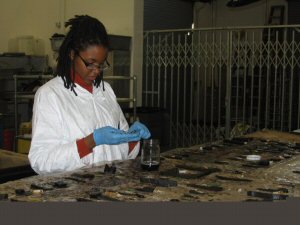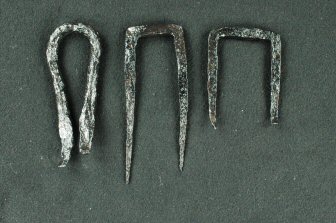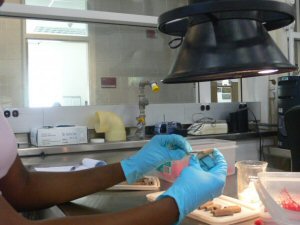Jamestown Project
October 2008
By Kenya Brown Fusciello, MAC Lab Conservator
The Jamestown Project derives from Historic Jamestown, Virginia, where an archaeological assessment recovered artifacts including many iron and ceramic fragments, a significant number of them being Colonial period pipe fragments. These excavations, led by noted archaeologists J.C. Harrington and John Cotter, occurred between the 1930s and the 1950s. Subsequently, they were treated by Civilian Conservation Corps (CCC) and National Park Service staff.
Artifacts uncovered at Jamestown are from the Colonial period of the early 17th century. When English colonists settled on the island at the time it was heavily wooded and contained marshlands. Jamestown was settled in 1607 and served as the capitol of Virginia for 92 years. By the arrival of the 18th century, Jamestown’s infrastructures were soon abandoned by its inhabitants. Tobacco fields were then cultivated in place of abandoned farmsteads (Jamestown Archaeological Assessment, 2001:3). Today's Jamestown is a historic site jointly administered by APVA Preservation Virginia and the National Park Service location where thousands of objects dating from these periods are in storage facilities and on display at the park's visitor center for public exhibition.
In 2003, Jamestown staff members prepared the site for the onslaught of Hurricane Isabel in accordance with its emergency plan to prevent any type of flooding. Unfortunately, the combination of the hurricane and its related storm surge brought in waters from the nearby Pitch and Tar Swamp measuring five feet deep at the National Park Service Visitor Center. Consequently the artifacts were adversely affected and are undergoing treatment at the Maryland Archaeological Conservation (MAC) Laboratory in St. Leonard, Maryland. Approximately 34,000 of those objects were sent for re-treatment as a part of an agreement between the National Park Service under the Department of Interior and the MAC lab. The remaining objects were being treated in other major laboratories on the east coast and at a National Park Service facility near the park.
The MAC Lab found, by Fourier transform infrared spectroscopy (FTIR) testing, that the iron objects were coated with paraffin wax intended to act as a protective layer and/or consolidant in some cases as a result of their first treatment in the 1950s. Although the wax offered some protection, the irons suffered some corrosion due to brackish water flooding stemming from the hurricane.
Iron artifacts that are exposed to water and oxygen will show a reddish brown corrosion superficially (Fig.1). At lower relative humidity (RH) levels, corrosion is probable if the surface has been in contact with salt also known as chlorides (Canadian Conservation Institute, 2002). As with most of the irons in the project, rust will appear on the surface layers of the objects if the indoor RH is at 65 percent or higher. Exposure to chlorides can contribute to the corrosion which is evident from the loose powdery residue seen on many of the irons from Jamestown.
 |
| (Fig.2, Measuring chloride levels) |
The first stage of the re-treatment and stabilization process begins by placing the objects in a solvent recycling still using a hot xylene vapor for six hours to remove old paraffin wax layers remaining from the previous treatment. Once they have been de-waxed they are moved into various storage bins containing reversed osmosis water (RO) and a small percentage of sodium hydroxide (NaOH) with regard to volume of RO used. Chloride readings are logged daily by the laboratory's conservators in order to determine if the levels indicate the removal of soluble salts from the objects (Fig. 2).
The objects are removed from desalination and are immersed in bins containing deionized water. The bins are placed in a hot wash at a temperature of 140 degrees Fahrenheit, 65 degrees Celsius for the elimination of any more soluble salts and to neutralize the objects. The water's pH is measured and changed daily until the level reaches the neutral standard measurement.
Next, the objects are set to dry in an oven for no more than three days, thereafter tannic acid is applied. (Fig. 3) Tannic acid is comprised of a group of water and alcohol soluble products that are effective for the stabilization of iron oxide and converts it into an iron tannate after application (Matlby, 1998). Jamestown artifacts may receive between two to three coats of tannic acid depending on the extent of the object's corrosion. Thereafter, the irons lose their brownish color and take on a black finish (Canadian Conservation Institute, 2002).
The final phase in treatment includes a protective coating containing Acryloids B48 and B67 mixed in a solution of acetone and xylene. After the objects are coated they are labeled and packaged for return to the Jamestown facility (Fig. 4).
 |
 |
| (Fig. 3, Tannic acid application) |
(Fig. 4, After tannic acid and coating) |
 |
(Fig. 5, Cleaning pipe fragments
using acetone) |
Unlike the iron, the treatment cycle for the Colonial pipe fragments does not require as many steps. The pipe fragments are separated in small nets according to their conservation accession numbers and set in an acetone solution for a period of one to two days. The pipes were removed from the solution and then cleaned using a cotton compress containing acetone (Fig. 5).
Once the cleaning process is finished they are placed again in the nets to soak in deionized water where daily chloride levels were recorded. PH levels between four and five are required in order to receive an accurate chloride reading measured in parts per million (ppm). If the ppm results were below the number five, the fragments were removed from their nets and put onto a tray to dry for one to two days. Each fragment is labeled, coated with a mineral oil mixture to protect the number written, and packaged for return to Jamestown.
Approximately 23,000 ceramic pipe fragments and a number of wood objects have completed treatment and have been returned to Jamestown's facilities intermittently throughout the span of the project. There remain over 5,000 objects that are still undergoing assessment and treatment including iron and ceramic shards. The project is anticipated to end September 2009.